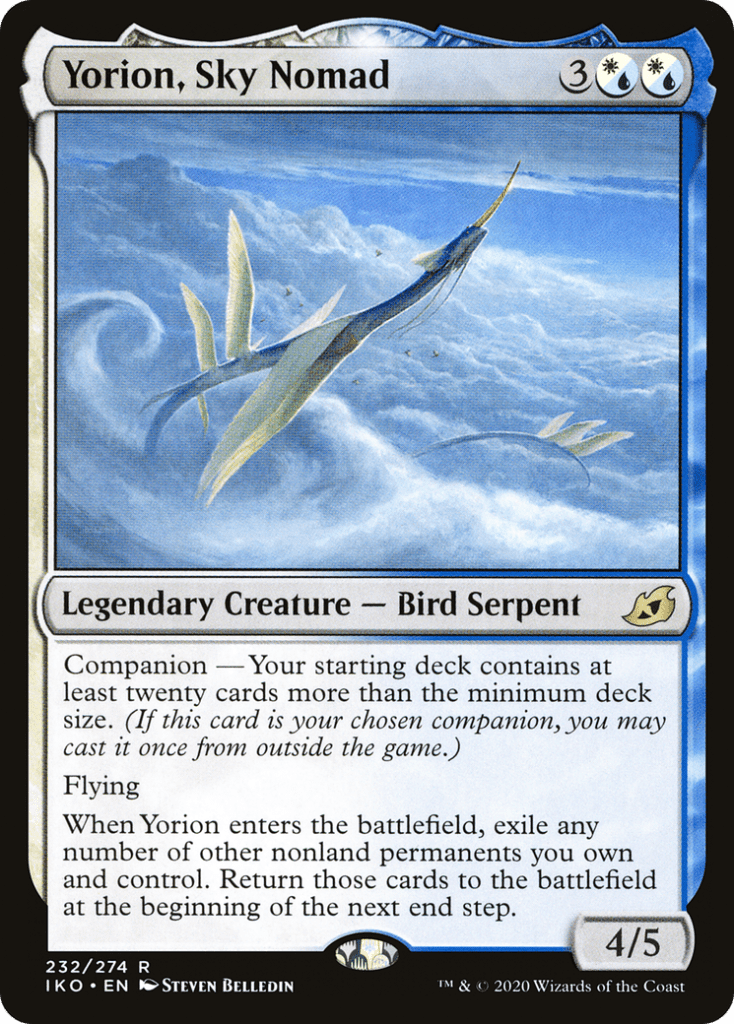
Cards with strong abilities that activate simply for entering the battlefield are often beloved by Magic: The Gathering (MTG) players, regardless of your favorite way to play the game.
When you think about it, this makes total sense. The ability for a creature to do its cool thing, even if it eats an immediate removal spell like Doom Blade, softens the blow of seeing it killed or exiled before you can attack or tap with it. This feels a whole lot better than when you lose a creature like Adarkar Valkyrie, which needs to do either of those things to truly shine.
While these “enter the battlefield” (ETB) abilities tend to be very straightforward, there are still a wide array of effects that can be triggered this way. Mundane boons like a temporary toughness boost all the way up to powerful abilities like destroying several of your opponents’ permanents can be found stapled to new creatures across MTG’s history, with new ETB effects coming out all the time.
Many of these abilities are so powerful and/or useful that whole Commander decks are dedicated to duplicating and reusing them. One of the most popular strategies for abusing these mighty effects is the blink deck, so we’re going to take a look at the best Commanders capable of blinking your permanents for maximum value.
What is a Blink Deck?
A blink (or flicker) deck temporarily removes creatures from your battlefield (usually by exiling), then returns them to play in order to trigger effects that occur when they enter the battlefield. This strategy can also include other permanent types and/or abilities that trigger when a permanent leaves the battlefield.

While most newer players will think of Momentary Blink or Ghostly Flicker when discussing a blink/flicker deck (the terms are interchangeable), many MTG players who have been playing since the 1990s will tell you that these terms have been around as long as Blinking Spirit and Flicker.
Looking back, I’m surprised that these were both rares, given how often you see blink effects at common and uncommon these days, but I also really appreciate that the blink mechanic has evolved to the point where we don’t have to return creatures to our hands anymore!
That said, I can understand why Wizards of the Coast was careful about introducing these types of cards to the game. While abusing ETB effects is the most common use for a deck designed around blinking permanents, it’s easy to forget that a properly timed blink card can effectively counter a removal spell.
This is because a targeted removal spell like Tragic Slip will lose its target when you blink it away with an effect like Ephemerate. The removal spell simply can’t follow the move of its target to another zone of play – even if the intended target has already returned to the battlefield from that move. As a result, it will simply fizzle out on resolution.
Cards like Ghostway or Eerie Interlude are examples of blink cards that ramp this defense up to the next level, each being capable of turning a board wipe like Supreme Verdict against the rest of the table, regardless of who cast it.
Naturally, this defensive style of play also lends itself to a level of resilience that often makes it very hard to slow a blink deck down once it gets going. Attempts to stop it from taking over the game can simply turn into opportunities for further dominance if your opponents fail to carefully time their cards.
Traits of Good Blink Commanders
When building a blink deck for Commander, you’ll usually have one of two types of commander in mind. The first, which will be the focus of this article, are commanders that enable you to blink your permanents, effectively ensuring you always have access to a blink effect to reuse ETB triggers, protect your creatures from removal, or both.
The second type of blink deck focuses on a commander who has such a powerful ETB effect that it will generate insurmountable advantage over multiple uses, assuming it doesn’t go infinite or find another way to win you the game on the spot.
Both types of blink deck can be extremely powerful, but as most blink cards are white, blue, or both, you almost always need access to at least 1 of these 2 colors in order to build a viable commander deck focused on this strategy. Fortunately, that isn’t much of a hardship, as no color in MTG has a shortage of stellar ETB effects to choose from.
So to summarize, a good blink commander focused on enabling your blink deck must:
- Have white or blue in its color identity (ideally both)
- Allow you to easily and/or repeatedly blink your permanents
- Not cost more than 6 mana to cast or use (though the less mana you have to spend, the better)
So which legendary creatures enable blink’s unique brand of shenanigans most effectively? Let’s dive in and have a look!
Note that the cards presented are in no particular order when it comes to power level. Any are capable of having a good, optimized blink deck built around them, though some will be easier to build around than others.
Aminatou, the Fateshifter

Aminatou, the Fateshifter is surprisingly straightforward for a planeswalker commander, limiting the decks it can bring the best out of when at the helm. Fortunately, blink decks are at the top of this short list, and with access to 3 colors, including both blue and white, you’ll find there’s a lot of flexibility when it comes to building your deck.
3 mana for a 3 loyalty planeswalker is also an excellent rate, allowing you to play Aminatou early for access to an extra card in a pinch, providing easy setup of an inexpensive permanent with a relevant ETB ability and Aminatou on the same turn, or simply letting you play Aminatou late with mana up to protect it from countermagic or removal.
Most importantly, Aminatou has the ability to blink any permanent you own, returning it to the battlefield after exiling it. Lands that tap for multiple mana like Ancient Tomb can come back untapped to accelerate your big plays, permanents like Gilded Drake that you traded away to an opponent let you ensnare another big creature, or you can simply retake something stolen by an Agent of Treachery!
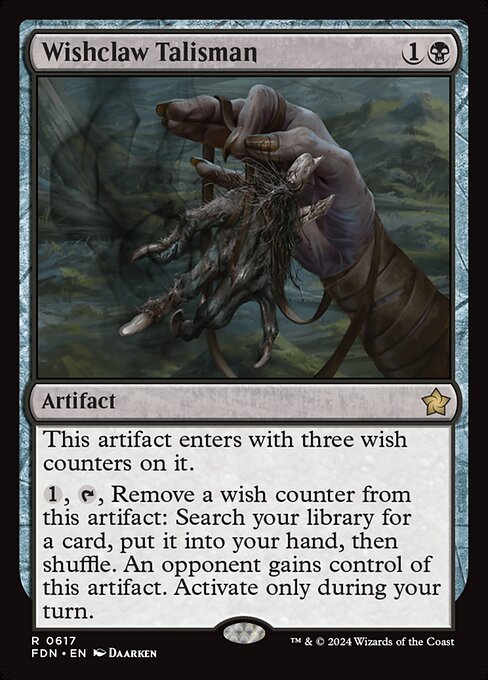


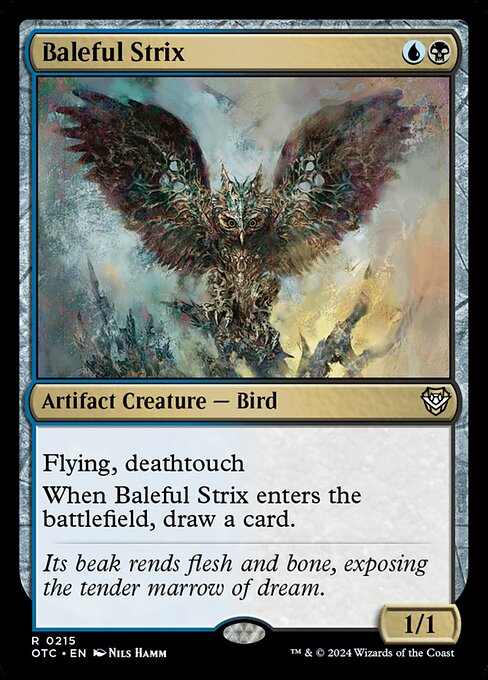
Plus all the normal shenanigans a blink deck brings to the table on its own, of course.
This incredible flexibility in a relatively narrow strategic space makes Aminatou the perfect commander for brewers who want access to a wide pool of cards, the ability to make an optimized deck that can hang out at the more competitive levels of play, and/or the chance to do something truly silly during a game of Commander.
Athreos, Shroud-Veiled
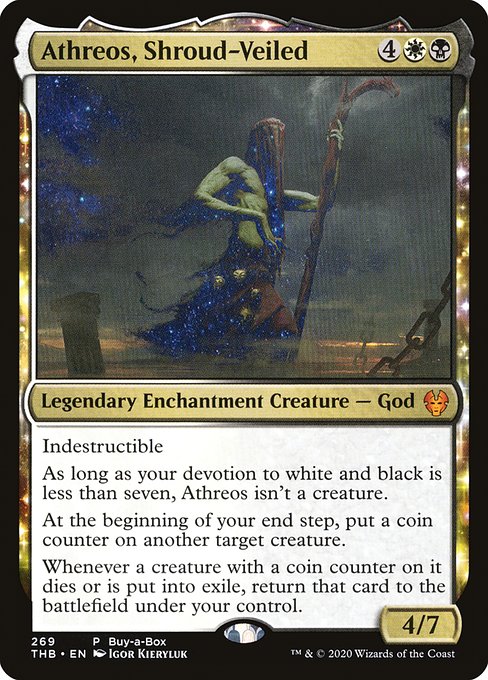
Of all the blink commanders in this list, Athreos, Shoud-Veiled is easily the most unconventional. Rather than initiating the blink of a permanent on your battlefield like every other entry on this list, Athreos instead sets creatures up to be blinked whenever one with a coin counter dies or is exiled, immediately bringing it back to the battlefield under your control.
While this trait (plus being indestructible) was what earned it my attention when talking about good reanimator commanders, you can just as easily build your Orzhov deck around creatures with powerful ETB effects and ways to kill them off to do a good impression of a traditional blink strategy too!
Best of all, you aren’t limited to your own creatures, so if your opponent plays something generically powerful or packaged with a useful ETB effect, slap a coin counter on it, kill it off, take it for yourself, then slap another coin counter on it to repeat the process if it survives to your end step.
Just make sure not to use one of your other flicker spells on it once you take control – most will return the flickered creature to its owner when it reenters the battlefield.
Triad of Fates
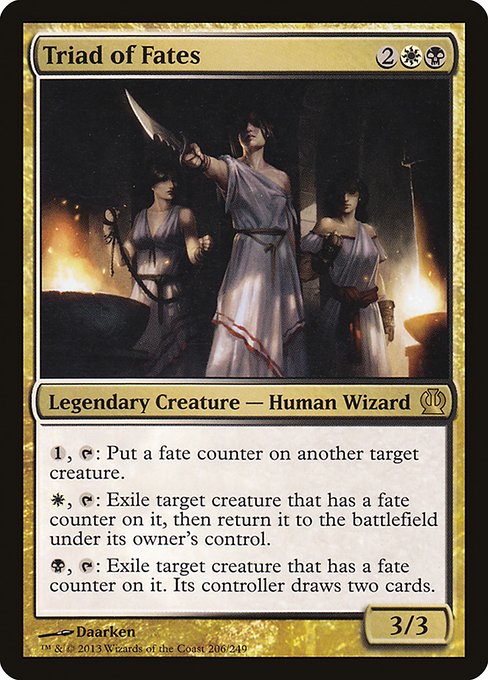
Triad of Fates is probably my least favorite entry on this list, as it is slow to activate, taps to use any of its 3 abilities (the latter 2 of which require a prior activation of the 1st), and takes multiple turns to get off the ground once you can activate its effects unless you have Oblivion Stone in play.
This makes it even slower than Athreos, Shoud-Veiled, whose effect only comes around once per cycle of the table (though admittedly, you only need to wait until your end step to get your first use). Unlike Athreos, however, there are ways to get around the restrictions of Triad of Fates, which can quickly grant you access to blinking, removal, and card draw from your command zone.
Effects that grant or emulate haste are going to be a top priority when building around Triad. Lightning Greaves, Swiftfoot Boots, Thousand-Year Elixir – include whatever cards you have to in order to ensure Triad can tap the turn it comes down.
Your secondary priority is going to involve finding ways to untap your commander. This is where cards like Puppet Strings, Staff of Domination, and Magewright’s Stone will come in very handy, as you can use them to stick a fate counter on a creature, then blink or sacrifice it as needed.
This is especially useful if you need to remove an opposing threat, even one that is indestructible, in a hurry. Two cards is usually worth the price of getting a creature like that off the table.
Finally, if you want to duplicate the effects of Triad of Fates to more quickly spread out fate counters and increase your available options, consider Illusionist’s Bracers or Lithoform Engine.
While these additions are mana intensive, a Triad of Fates deck is already going to be a little mana hungry, so finding ways to quickly ramp your mana will already be a crucial consideration during deck construction.
Certainly not a bad commander, but definitely the one that takes the most work to do well within blink strategies right now.
Thassa, Deep-Dwelling
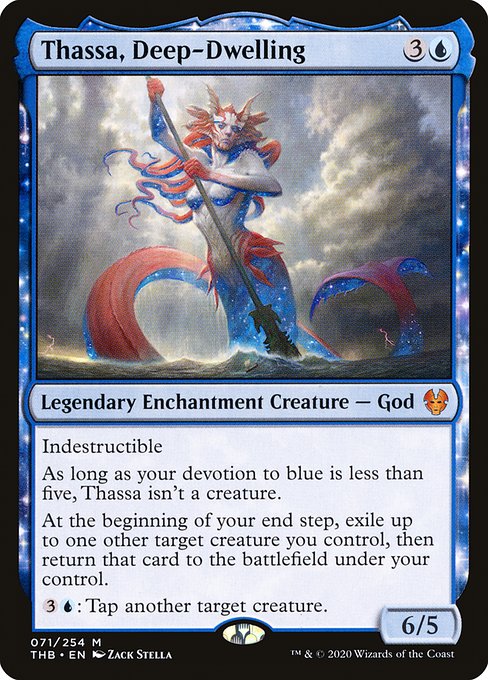
An indestructible Conjurer’s Closet that can tap problematic creatures and become a 6/5 creature pretty easily? Where do I sign up?
Thassa, Deep-Dwelling is the only blink enabling commander that forces you to build a monocolor deck, but despite placing the greatest restriction on your available cards, there are still a lot of powerful interactions it can bring to the table with surprising ease.
First, unlike its fellow pantheon member Athreos (who I promise to stop picking on, I swear!), you actually get to blink another one of your creatures during each of your end steps. Not super flashy or flexible, but it doesn’t make you jump through any additional hoops either.
Second, blue’s affinity for instants, sorceries, and artifacts gives you a lot of possibilities when focusing on which creatures your deck wants to be blinking.
Snapcaster Mage and Archaeomancer make great blink targets for instant and sorcery focused decks, Archaeomender and Treasure Mage can be extremely helpful for decks revolving around big artifacts like Mindslaver and Metalwork Colossus, or you can just go for raw value with Agent of Treachery and Palinchron.
Speaking of Palinchron, it’s also very easy for a mono-blue deck to find ways to go infinite with its mana, which can translate to infinite blink effects, card draw, tapping down all your opponents’ creatures with Thassa, and other extremely convenient side benefits that can set you up to win the game.
For a full primer, I recommend checking out this Thassa, Deep-Dwelling post on Reddit. It thoroughly covers all the best ways to bring the most powerful interactions out of this deck and will set you up for victory during your next Commander night.
Livio, Oathsworn Sentinel
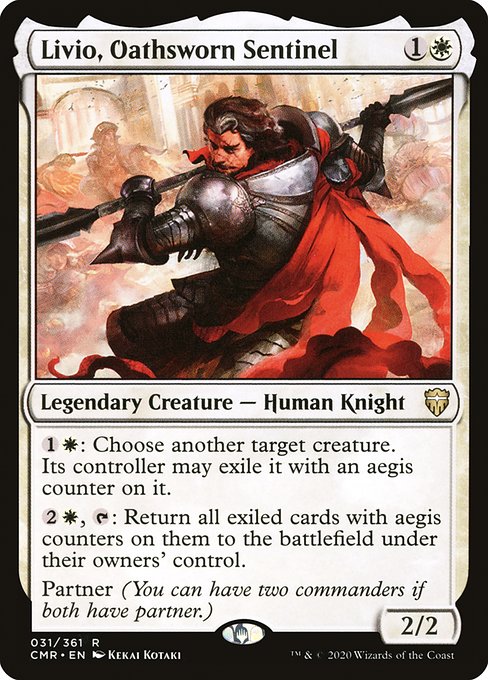
Most commanders that allow you to blink permanents don’t make you wait very long to bring them back, typically returning them to the battlefield no later than the end of the turn. Livio, Oathsworn Sentinel offers a different approach by allowing you to effectively bank them instead, then return everything you’ve banked to the battlefield for the low price of 3 mana.
This is actually an incredibly clever card design. Since Livio only costs 2 mana to cast, and 2 additional mana per creature you exile with an aegis counter, you can easily start setting this up early in the game, as commander tax is unlikely to render this commander unplayable later on.
As with Triad of Fates, cards that grant haste or allow you to tap Livio the turn it comes down will be key, but only when you’re ready to make a big move. This takes a little of the pressure off of trying to draw or protect them in the early to mid game, allowing you to concentrate on more pressing issues instead.
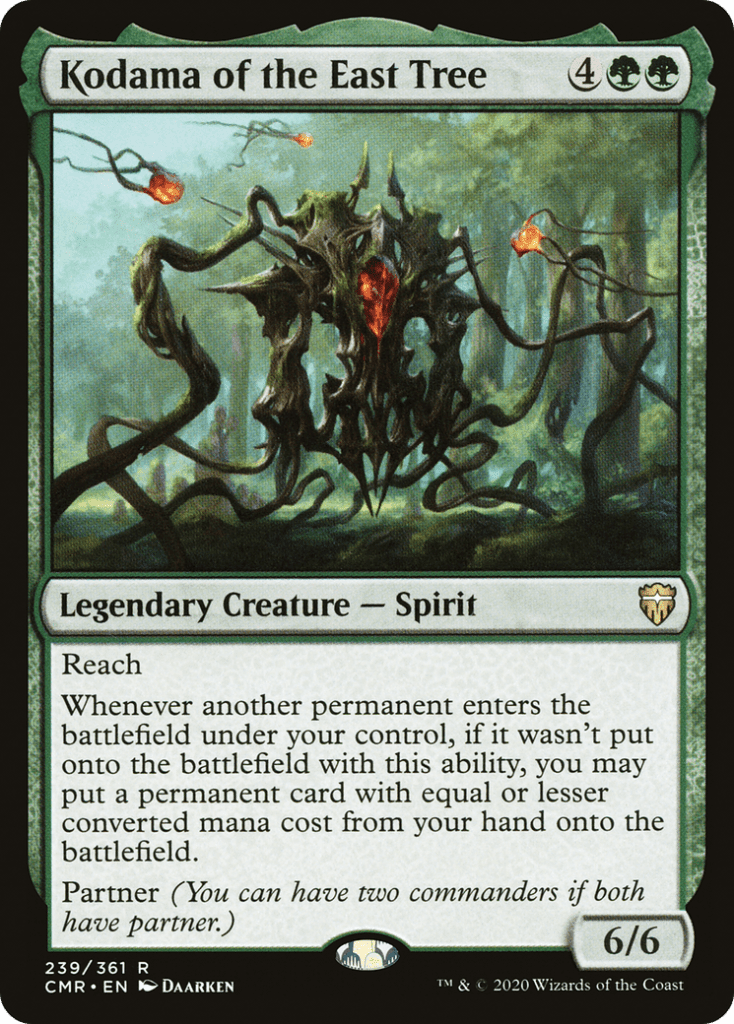
Livio also has Partner, meaning you can pair it with one other legendary card that has Partner in your command zone. This opens up access to any combination of 2-3 colors you could want for your blink deck, though I’d argue that the best partner commander to pair with Livio’s talents is Kodama of the East Tree.
Getting to play a lot of cards for free while scoring powerful ETB triggers will simply catapult you ahead of your opponents more often than not, and you’ll gain access to green’s powerful suite of mana ramp to fuel Livio’s abilities to boot.
Don’t feel limited to Kodama as your only partner option though – there are plenty of other powerful choices that will let you build around Livio to suit any type of blink deck you’re thinking about building.
Emiel the Blessed

Emiel the Blessed has a surprising amount of depth to explore. Sure, as a blink commander it’s pretty straightforward: pay 3 mana, blink another creature you control, watch it immediately come back to the battlefield, and rake in the value.
With a pair of colors well suited to ramping mana, putting Emiel at the helm can allow you to build an amazingly resilient deck, as seen on an episode of Game Knights.
On its own, this would be pretty awesome. It’s worth remembering that Emiel has two abilities, however, and the second ability, while appearing both unassuming and intended for other Unicorn creatures, offers incredible combo potential while requiring fairly minimal setup.
Phyrexian Altar, Ashnod’s Altar, Karmic Guide and Reveilark – the usual suspects are joined by several others to lend their expertise in creating infinite combos for mana, creatures, destruction of permanents, and life to exert true dominance over a table.
For a couple of quick primers, I recommend Sultai_Sir’s guide and Zach’s Game Knights decklist used in the video above.
Sultai_Sir leans hard into the more conventional infinite loops Selesnya decks can pull off, while Zach’s deck pushes for incremental value that can become explosive with light application of +1/+1 counters or Village Bell-Ringer unless multiple opponents work together to keep it from going off.
Each showcases an excellent build that offers a lot of blink value and combo potential, electing to execute them in very different ways. Best of all, these lists only scratch the surface of Emiel’s deckbuilding possibilities, so feel free to experiment until you find the build that’s right for your playstyle.
Brago, King Eternal

The general consensus is that Brago, King Eternal is the most powerful blink commander currently in the format, frequently showing up in cEDH and casual decklists alike. Having been around the format a time or two myself, I’ve got to say there’s a lot of supporting evidence to back up this claim.
If you’re building Brago for cEDH, it makes a mean stax commander. Choke out your opponent’s resources, hit someone with Brago when their shields are down, blink as many of your permanents as you want to untap them and break parity (including Brago himself), then grind the table down or set up a combo to win the game as desired.
Not a load of laughs to play against outside of cEDH, but you can’t deny the effectiveness of this strategy.
Those seeking to do slightly less terrible things to their friends during casual commander games will find repeatable mass blink effects that net you cards (Cloudblazer, Unquestioned Authority, etc.), the ability to get around mana costs through the Manifest mechanic (Cloudform, Scroll of Fate, etc.), or even double mana from mana rocks is plenty sufficient when it comes to generating incremental value.
Either way, this deck is heavily reliant on Brago to pull off its shenanigans, so finding ways to protect him will be a top priority. Fortunately, Azorius decks have ample access to both blink spells and counterspells, so this should be comparatively easy compared to other color combinations.
Yorion, Sky Nomad
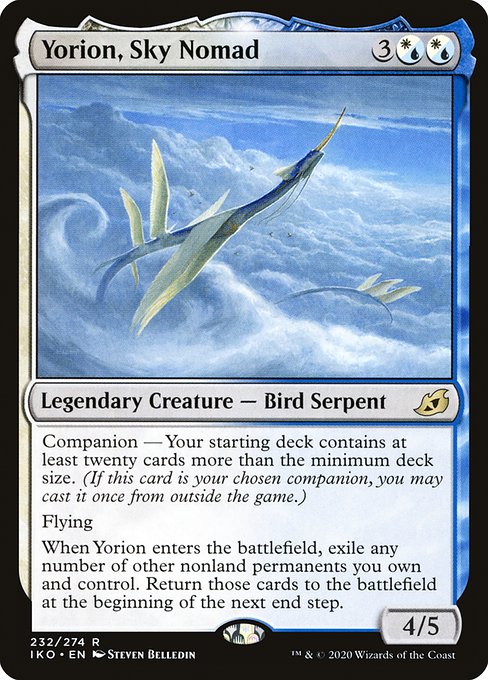
Yorion, Sky Nomad, while unable to be a Companion in Commander, offers a level of immediate payoff from the command zone that puts all other blink-focused commanders to shame. Simply by entering the battlefield, Yorion can blink any number of your other creatures, watch them come back into play at the end of the turn, and then reap the rewards of your ETB effects.
While this opens up some fun tricks if you can find a way to give Yorion the ability to be played at instant speed (flash), you are also able to turn a blink spell that targets only one creature into a blink spell that can target as many as all of your creatures.
That’s a pretty big upgrade in and of itself, but Yorion’s blink effect also pairs well with mass blink spells like Ghostway, allowing you to blink most of your creatures twice if you’re so inclined.
Factor in a blink spell’s ability to protect your creatures that are on the battlefield from being destroyed, exiled, or bounced, and you’ll have a truly infuriating level of power and resilience in the mid or late game that opponents will frequently struggle to answer.
Especially if you introduce a creature like Restoration Angel or Felidar Guardian into the mix.
Roon of the Hidden Realm
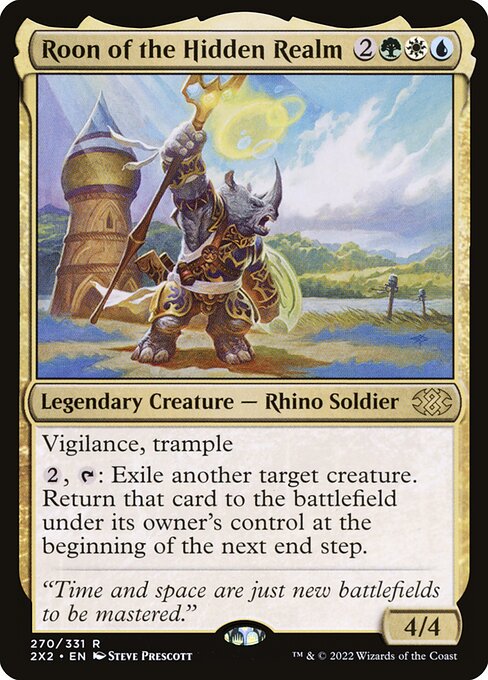
Roon of the Hidden Realm was one of the only possible commanders you could run for some time that had a built-in ability to blink creatures, which has kept it a popular commander since its release in Commander 2013.
Being a 4/4 with vigilance and trample is also quite helpful, as it allows the possibility of threatening lethal commander damage without giving up access to its ability during games that run long.
While I could extoll the virtues of having access to the best colors for blink effects when building a Roon deck, or the ability to use them to blink powerhouses like Avenger of Zendikar, Craterhoof Behemoth, or Eternal Witness, Roon actually has a much more sinister claim to fame thanks to the rules change involving death triggers in 2020.
Put simply, if Roon or another blink effect exiles a commander, the commander’s owner now needs to decide whether to return it to the command zone or leave it exiled. If they leave it exiled, the part of the effect that triggers its return to the battlefield at the end of the turn can be countered with a card like Stifle or Disallow.
Should this happen, the commander is then exiled permanently, and only cards like Pull from Eternity or Riftsweeper can ever pull it back.
This gives Roon the unintended ability to be a commander killer, as it has access to all the counterspells currently capable of targeting triggered abilities. Should one be printed in white and/or black, Triad of Fates will become capable of filling this role as well, but as white only very rarely receives access to countermagic, it will be a long time before this becomes a reality, if ever.
Even if Roon isn’t your commander, as long as your blink deck has access to blue and/or green plus a blink spell that can target opposing creatures, this can be a nasty little trick that your opponent probably won’t see coming the first time, and one they’ll have to consider playing around thereafter.
How to Win with a Blink Deck
Blink decks are typically aiming for one of two ways to win. The first and most common path to victory is incremental advantage. Your ETB effects should always be striving to advance your position in the game through drawing cards, putting more cards into play, taking away your opponents’ cards, countering your opponents’ removal spells, or some combination of the above.
To master the art of incremental advantage, you need to develop a sense for knowing when to push for a play yourself and when to react to what an opponent is doing. Casting a powerful blink spell in a vacuum might look good on paper, but if your opponent responds with a removal spell, they’ve effectively countered you, rather than the other way around.
On the other hand, waiting too long to play around a threat that isn’t coming may give your opponents time to draw an answer to your board state, which can cost you resources or even the game itself.
In short, timing is the single most important and difficult part of mastering blink cards.
This is also a good lesson to bear in mind with blink’s other common win condition, infinite combos. Waiting for a moment when most or all of your opponents are tapped out and/or short on cards in their hands gives you the best chance of going off without interruption, barring free counterspells like Force of Will and Force of Negation.
My final note here is that blink strategies aren’t going to be for everyone. If you prefer aggressive decks that like to attack with large numbers and/or big creatures in combat or strategies that impose your will on the table as quickly as possible, you might find blink’s need for pacing and patience to be a tedious element of gameplay.
If you’re looking for something different that tends to thrive the longer a game goes on, however, I’d definitely recommend building a blink deck for your next Commander game night. There are plenty of strategies and color combinations available to you, and the gameplay tends to be pretty laid back without necessarily producing a lower power level.
Other MTG Articles You Might Enjoy
- MTG’s Best Blink Commanders (Payoffs)
- Best Blue Tutors for EDH
- Best MTG Commander Dual Lands
- Best Green Mana Ramp for EDH
- MTG Death Triggers Rules for EDH
- MTG’s Best Mana Rocks for EDH
- Reanimator EDH Commanders You Should Build
Braden is a founder of Assorted Meeples and has been a gamer & writer with a vivid imagination all his life. Don’t believe us? Check out his excitement when meeting Goosebumps author R.L. Stine as a kid! An avid Magic: The Gathering spellslinger for over 15 years, you can always convince him to shuffle up for a game (or three!) of Commander.
